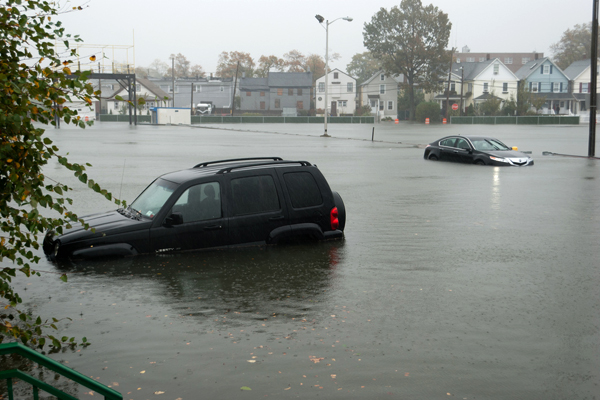The story in two videos.
First, an NBC news report from Staten Island.
[protected-iframe id=”943c7571cd06524b470b2075d2b21774-5104299-36375464″ info=”http://www.msnbc.msn.com/id/32545640″ width=”420″ height=”245″]
And this, shot along the Jericho Turnpike on Long Island.
Let’s tackle the second problem first. We mentioned yesterday that the region’s gas supply was running low. It’s now past the “E.” Cab service has been reduced, as drivers run low on fuel; other services that rely on gasoline have been similarly curtailed.
Very few cabs in Manhattan today–no gas. Cabbie refused to take me to LaGuardia saying not enough gas. So took a livery cab for $80
— Richard Edelman (@richardwedelman) November 2, 2012
Gas situation is nuts. Guy up street can’t get tree removed from house because tree guy ran out of gas to fuel saws.
— Bespoke (@bespokeinvest) November 2, 2012
There are two problems: too little gas and too little electricity. Ongoing power outages for millions of customers in the region means that gas stations, too, are dark. And without power, stations can’t pump gas even if they have it. Con Edison suggests that power restoration could take an additional week, particularly in areas with a lot of overhead lines — meaning less dense areas, meaning those places more likely to also be home to gas stations. CNBC has a good overview of why the gas shortage could last for days.
The situation is tense and decaying. A man in Queens was arrested after pulling a gun at a gas station line. Another week of this is not reassuring. The only silver lining? Anecdotal reports suggest that traffic is flowing more easily than it has over the past few days, as fewer cars are on the road.
Right now someone in an all-electric Nissan Leaf is tearing past miles-long lines for gas in Jersey, laughing her head off.
— Christopher Mims (@mims) November 2, 2012
The situation in Staten Island is, of course, much worse. Along the shore, houses leveled. The island still flooded in regions. No electricity, no running water, little food. And yesterday, emergency workers found the bodies of two children washed away in the flood water, bringing the total number of deaths on the island to 19. The borough president made headlines yesterday afternoon when he attacked the lack of response from the Red Cross, suggesting people refrain from donating to the organization.
Staten Island’s main problem is the same thing that its residents find so appealing: It’s hard to get to. There are four bridges to the island, including the Verrazano Narrows, which is the island’s only physical connection to the rest of the city. Otherwise, the only way on or off is by boat. A small bit of good news in that regard:
Staten Island Ferry Service Resumes At Noon #ny1sandy
— NY1 News (@NY1headlines) November 2, 2012
NBC’s report on the island’s dire situation has made a political problem for New York City Mayor Michael Bloomberg even worse. The island is the starting point for the New York City Marathon, scheduled to run on Sunday, as planned. There has been an enormous outcry in favor of canceling the race, but Bloomberg, true to form, has been unmoved. The Times has a discussion some 500 comments long arguing the pros and cons (and then more cons and more cons); New York magazine has a summary version.
Last night, tech writer Mat Honan noted the souring mood in New York City, and wondered why the city had grown so much more noticeably pessimistic. He got some interesting replies:
@mat I think just the realization of how long it will be before things are really back to normal.
— Buzz Andersen (@buzz) November 2, 2012
@mat Not personally in a position to complain, but my guess is that involuntary camping in 40 degree weather gets old after a few nights.
— Dan Frommer (@fromedome) November 2, 2012
@mat we’ve found out what’s going on beyond the media stories. Some of us just got to places where we can tell the story.
— Anil Dash (@anildash) November 2, 2012
I can say from some experience that this is true: There’s very little cell reception in lower Manhattan and very little power there and elsewhere. Complaints don’t travel far offline.
This tweet all but sums it up, with every drop of warranted emotion.
@mat everyone realizing how badly we got fucked, how long it’ll take to get everything running again. sobering. oh, and fuck the marathon.
— lia bulaong (@lia) November 2, 2012
Update: Probably not helping the case for the marathon: the discovery that two generators are already operating in Central Park to power the media tent. If deployed elsewhere, they could provide enough power for 400 homes.




